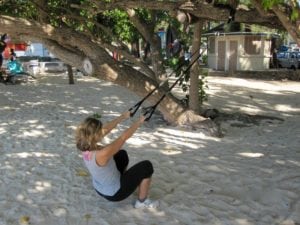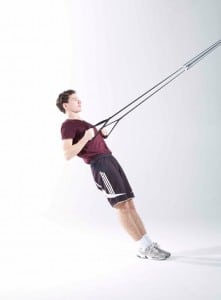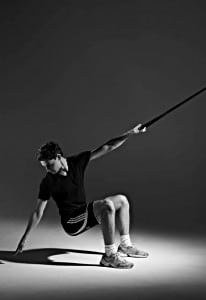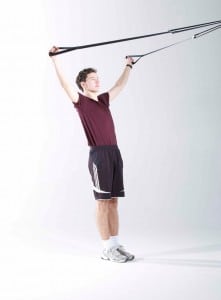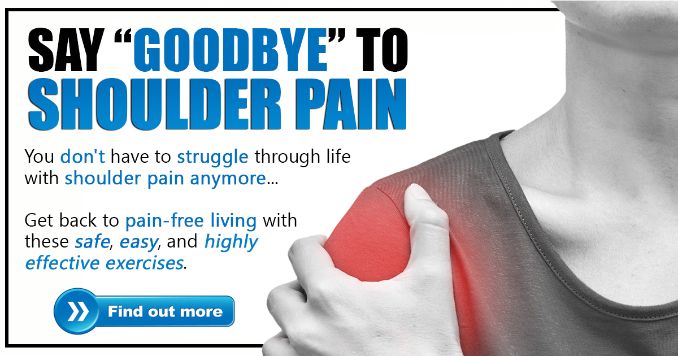
I have a guest blog post for you today on suspension training and the shoulder. It is from Zita Alves.
Enjoy the post, and make sure to try out some of the exercises.
Take it away, Zita…
I love to do bodyweight exercises, but there comes a time when you know something is missing – the pulls.
Not many people, especially women, can hop onto a bar and bang out a set of pull-ups, mainly if they are overweight.
It can be tough to achieve muscle balance without using gym equipment/dumbells, as pulling movements using the lats, rhomboids, trapezius, and biceps cannot always be overloaded enough by gravity alone need external force.
How many people do you see who have internally rotated shoulders and an overdeveloped chest?
From a postural point of view and a sports-specific standpoint, should we be looking at working the back musculature in equal measure? Given where the lats insert, isolated lat exercises or overtrained lat muscles can exacerbate this internal rotation which is why “rowing” movements are so beneficial to hit the rhomboid, mid/lower traps, serratus, and posterior deltoids.
Using a suspension trainer, you can do both horizontal and vertical pulling movements to target different muscles. You can hit the whole back from every angle by tiny adjustments in hand, elbow, or body position.
Be sure to set the scapula, shoulders down away from ears, and neck long for every movement. Here are some great exercises to try include:
REVERSE FLYES
Start
- Arms out in “T” Position in line with shoulders
- Hands facing forward
- Standing almost upright
Movement
- Lean back as arms come forward in front of the chest, hands facing each other.
- Lift arms back to start position keeping arms slightly bent, leading with top of hand
- Wrists strong, core braced, keep the chest up, squeeze shoulder blades down.
HIGH/WIDE ROW
Start
- Feeders out inline with shoulder
- Bent elbows, hands face down in line with elbows
- Lean back slightly
Movement
Lean back more as arms straighten in front of the body, hands facing down, chest up, core braced, back straight, wrists strong.
LOW ROW
Start
- Arms by the side, elbows bent
- Hands facing each other, in line with elbows
- Lean back slightly
Movement
- Lean back more as arms straighten in front of the body, hands facing each other, chest up, core braced, back straight.
- Pull leading with elbows, keeping shoulder blades down to bring arms and body back to start position.
- Pull leading with elbows, keeping shoulder blades down to bring arms and body back to start position.
ROTATIONAL SINGLE-ARM ROW & SQUAT
Start
- Hold one handle only
- Feet hip-width apart, slightly in-front of hands
- Bend knees to sit back, bottom towards the floor
- Arm straight and rotate the body to let other hand touch the floor Hands facing forward
Movement
- Push into legs simultaneously, pulling the handle to bend arm and row body up to the standing position; another hand can cross over strap.
- Straighten the arm and bend the legs to return to the start position
Y OVERHEAD RAISE
Start
- Components in the “Y” position
- Hands facing forward
- Standing almost upright
Movement
- Lean back as arms come forward in front of the chest, hands facing each other
- Lift arms back to start position keeping arms slightly bent, leading with top of hand
- Wrists strong, core braced, keep the chest up, squeeze shoulder blades down
Once the exerciser has mastered the fundamental movements with the excellent form, they can work on some great combinations such as the following:
- Low and high row combi
- Low row, reverse flye combi
- High row to Y raise combi
One of my favorite combinations is:-Y raise, high row, low row to bicep curl. Perform one rep after the other in a continuous movement, aiming for approximately five reps in total, or more reps depending on the foot positioning. The advantage of suspension training is that during a set if form deteriorates, the feet can be very slightly moved to make the exercise easier and maintain the time under tension.
One of the most remarkable ways to use the Ztrainer is for MYOFASCIAL STRETCHES. The body has lines that run through it, and tightness in these lines is very common and can lead to dysfunction. For example, one of the lines that I love to stretch for my clients is the anterior lines that run from the head down the front of the body through the hips down the legs into the feet. Incorporating the following movements is a great way to prepare the body for activity.
Lunge and chest openings
They were facing away from the anchor point, holding the handles lightly, arms straight and wide in T position, stepping forward into a lunge, tucking the pelvis under. Make sure fingers point back to add a slight nerve stretch.
Alternate feet and repeat with arms in more of a Y position
Developing this further, you can get an even deeper stretch. Step right foot forward into the lunge position, tuck pelvis under, and lift left arm. Keep your right arm down by the side and rotate the upper body slightly to the right to get a great stretch down the left side of the body. There are not many people who won’t feel this one!
Curtsey lunge and lat stretch
Facing the anchor point standing back with arms straight, take one leg behind into a curtsey lunge and drop chest to feel the lats stretch.
Side Stretch
Standing sideways to the anchor point, grab both handles with arms straight, feet under grips, and drop the hip slightly to the side.g., e.g., if the anchor point is on the left, drop the left hip out to the side to feel the left side of body stretching.
Do as many of the above as you feel your body needs.

For more information, go to www.ztrainer.co.uk.
Thank you so much, Zita.
Thank you for reading, until next time.
Rick Kaselj, MS

